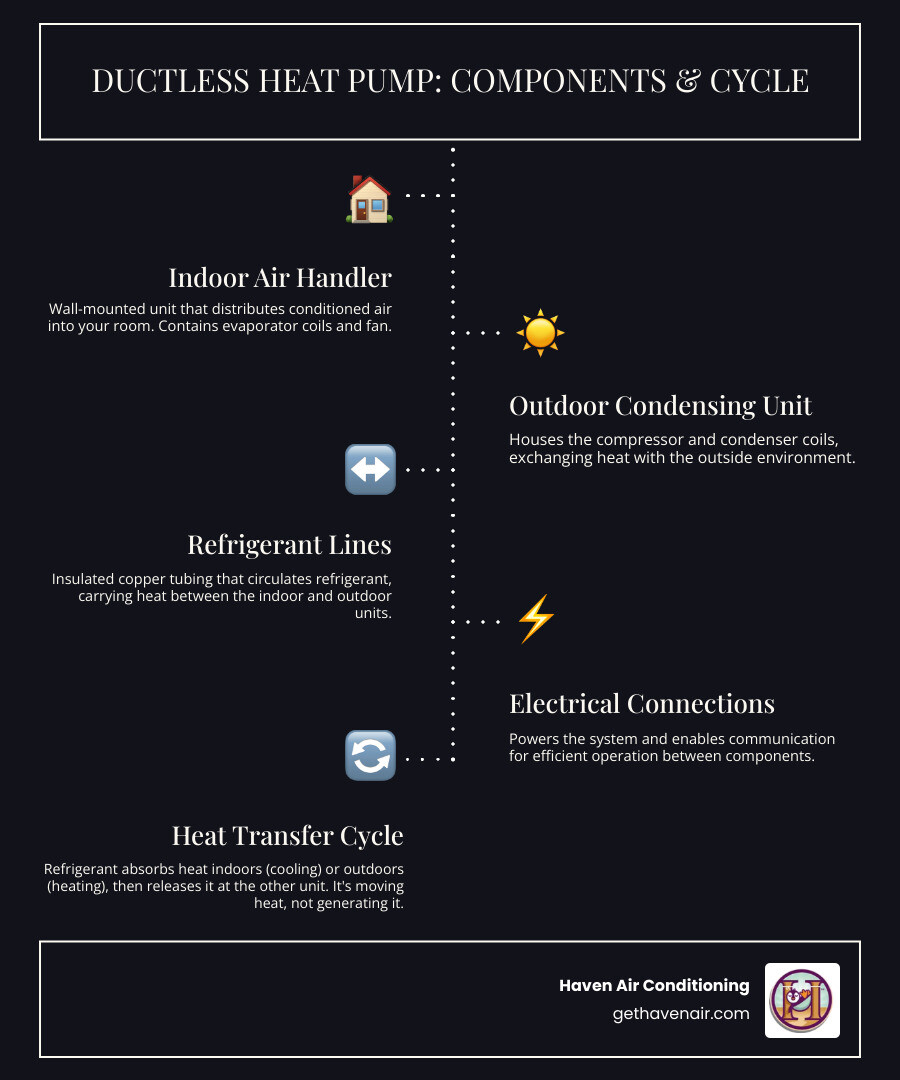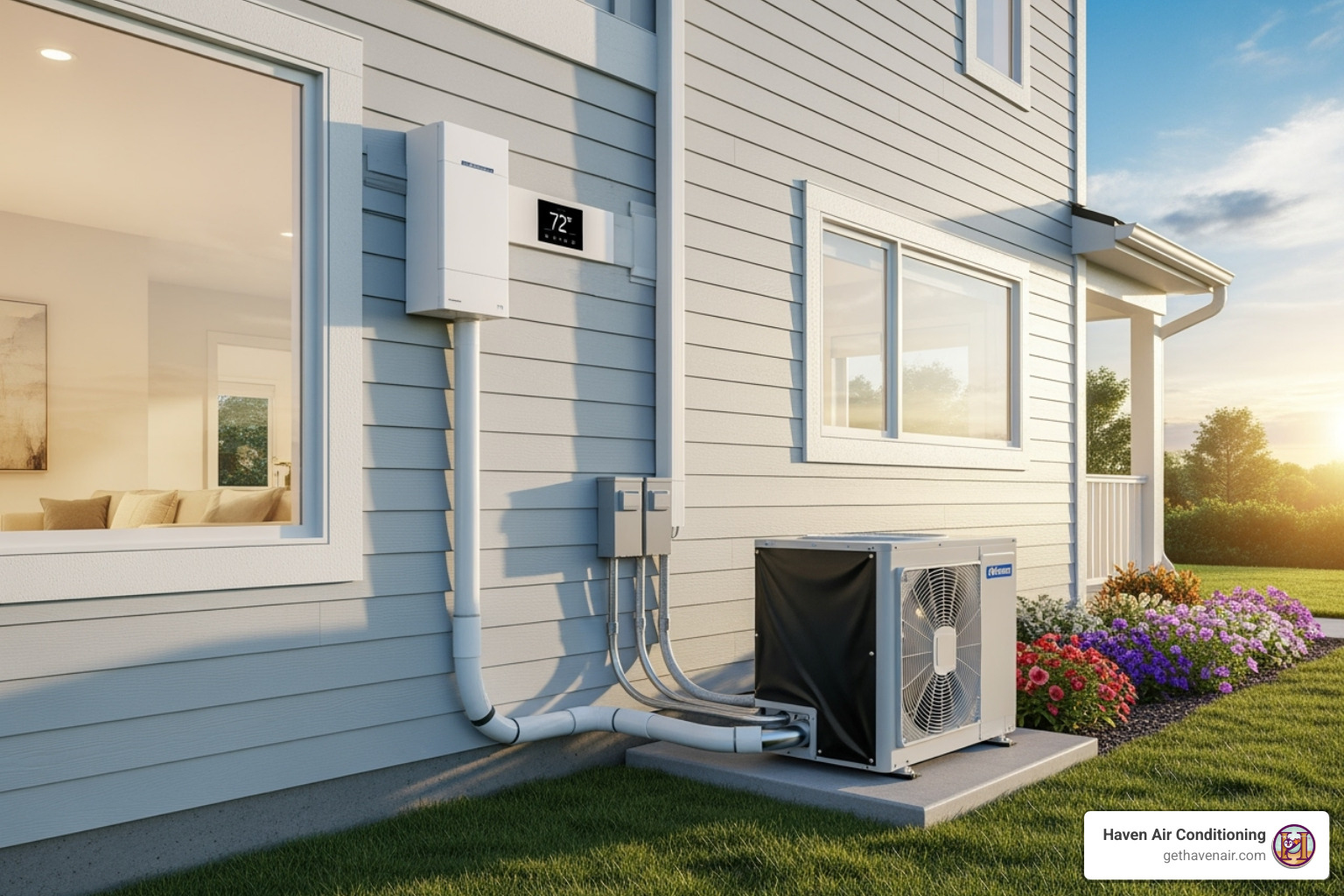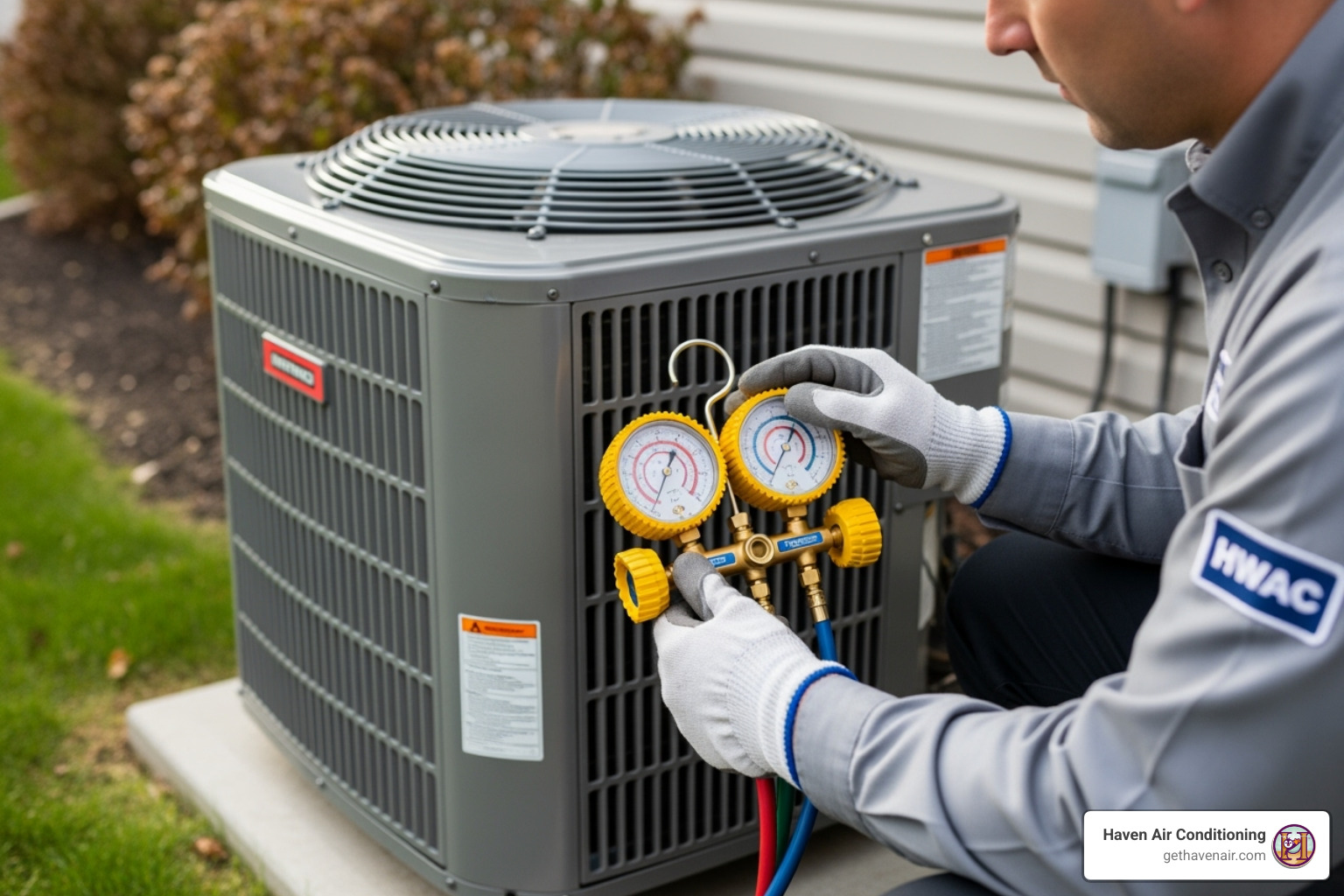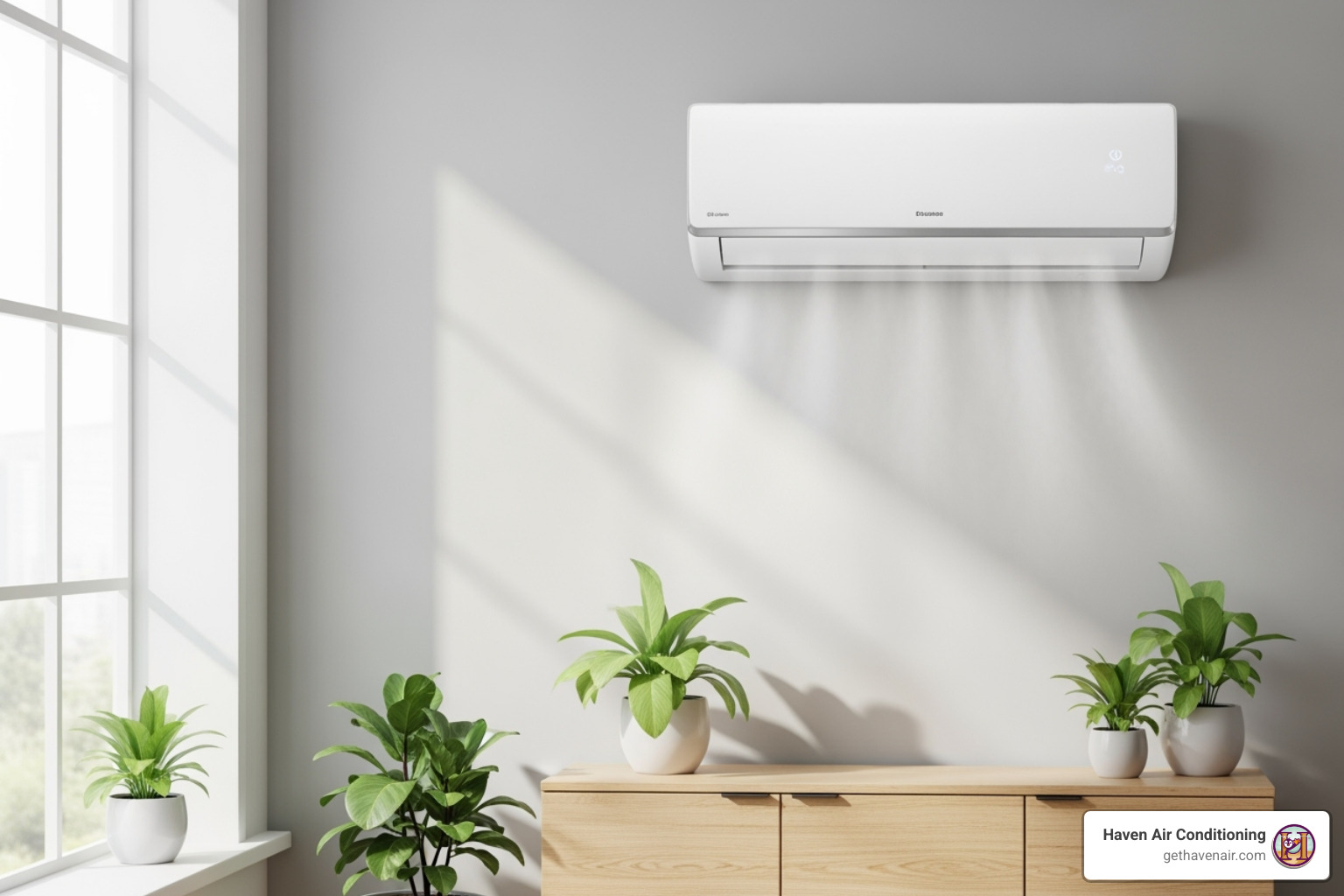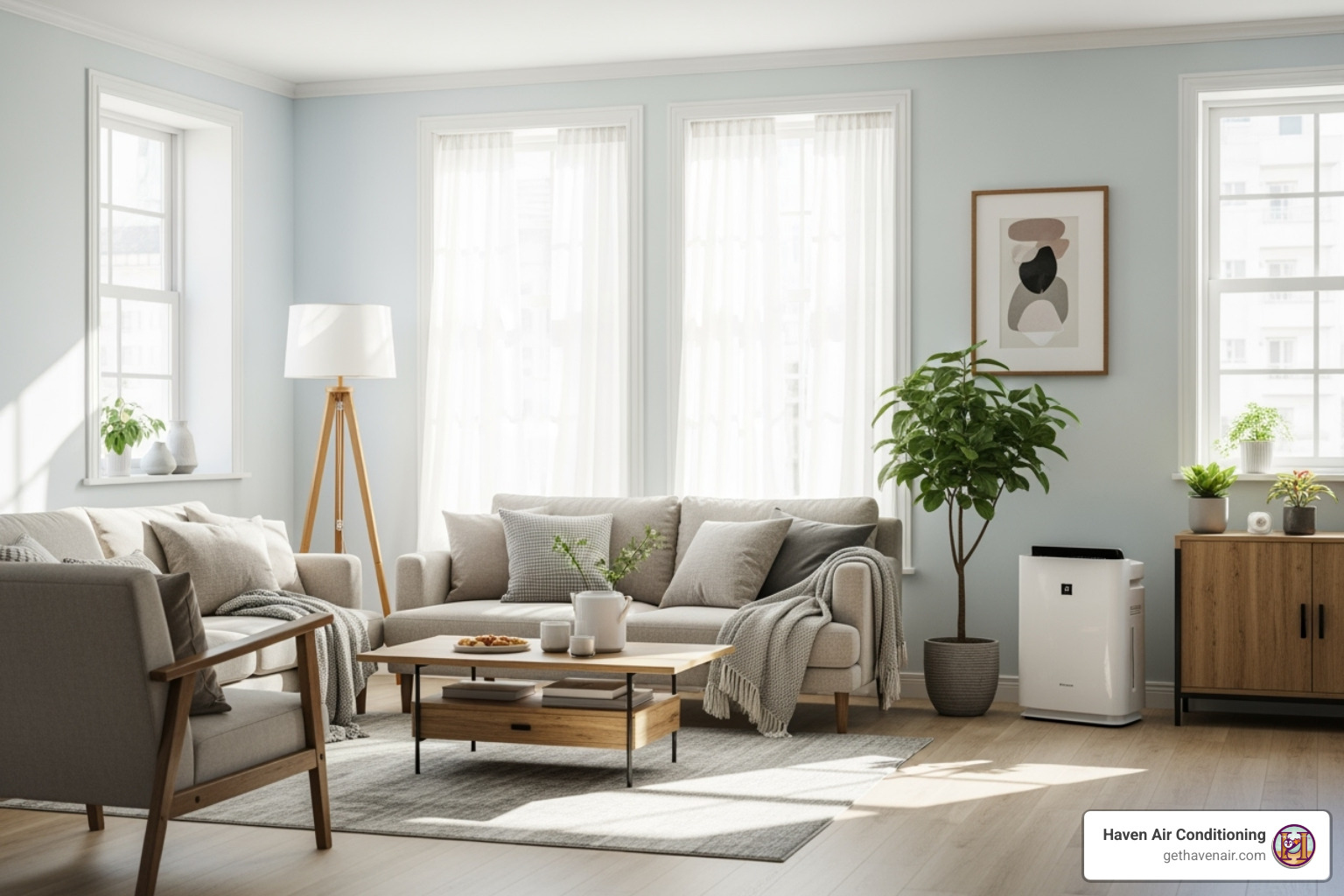Why Single Zone Ductless Heat Pumps Are Perfect for Targeted Comfort
Single zone ductless heat pump installation offers an efficient solution for heating and cooling individual rooms without extensive ductwork. Consisting of one indoor unit connected to one outdoor unit, they are ideal for additions, garages, or any room with specific temperature control needs.
Quick Installation Overview:
- Indoor unit mounts on an interior wall.
- Outdoor unit sits on a concrete pad or wall bracket.
- A small wall penetration (2-3 inches) connects the units.
- Refrigerant lines and electrical wiring run between them.
- Professional installation ensures safety and optimal performance.
These systems use heat pump technology to move heat rather than create it, making them far more efficient than traditional heating methods. The outdoor unit contains the compressor and condenser, while the indoor unit houses the evaporator coils and a fan to distribute conditioned air.
Modern ductless heat pumps offer impressive efficiency, with SEER ratings from 17 to 42—well above the Department of Energy’s minimum of 15. This translates to substantial energy savings compared to older HVAC systems or window units. Whether you need to cool a home office or add comfort to a converted garage, a single zone ductless heat pump provides targeted climate control exactly where you need it.
Why Choose a Single-Zone Ductless Heat Pump?
A single zone ductless heat pump installation is a smart alternative to traditional HVAC, delivering comfort precisely where you want it. Here’s why they are an excellent choice for your home.
- Energy Efficiency: Ductless heat pumps don’t burn fuel to create heat; they move it. This process is 2 to 4 times more efficient than conventional systems, potentially cutting your energy use by 30-60%. Learn more in our guide on Heat Pumps vs Air Conditioning.
- Zoned Temperature Control: Control one room’s temperature without affecting the rest of the house. This targeted approach saves energy and ends battles over the thermostat. Find more in our article on Zone Control Benefits with Mini Split AC.
- No Ductwork Required: This is a game-changer for older homes or additions where installing ducts is impractical. You avoid the mess, expense, and energy loss from leaky ductwork, which can waste up to 30% of your system’s output.
- Improved Indoor Air Quality: Advanced multi-stage filtration captures dust, allergens, and odors. With no dusty ductwork, the air you breathe is cleaner and fresher.
- Quiet Operation: The indoor unit whispers while it works, and the outdoor unit is designed for minimal noise, preserving the peace and quiet of your home.
- Increased Home Value: Energy-efficient features are a major draw for homebuyers. A modern ductless system is an investment in your daily comfort and your home’s future appeal.
Benefits for Specific Spaces
Single-zone systems are perfect problem-solvers for challenging areas. They bring comfort to additions, garages, and basements without the need to extend existing ductwork. They can tame the extreme temperatures common in attics, bonus rooms, and sunrooms. For any room with persistent hot and cold spots, a ductless unit provides targeted relief and balances your home’s overall comfort. For design ideas, see our article on Space-Saving Ductless AC in Modern Homes.
Understanding Efficiency Ratings
When shopping for a single zone ductless heat pump installation, efficiency ratings tell you how much you’ll save on energy bills.
- SEER (Seasonal Energy Efficiency Ratio): Measures cooling efficiency. The minimum is 15, but ductless systems often range from 17 to 42. Higher is better.
- HSPF (Heating Seasonal Performance Factor): Measures heating efficiency. Again, a higher number means greater savings in winter.
Look for ENERGY STAR models, which meet strict EPA efficiency guidelines. While high-efficiency models may have a higher upfront cost, the long-term energy savings often provide an excellent return on investment. For a deeper dive, explore our guide on What is a Heat Pump How Does it Work.
Understanding Your System: Key Components and Sizing
Before your single zone ductless heat pump installation, it helps to understand the key parts and how to choose the right size for your space.
A single-zone system has a few key components working together:
- Indoor Unit (Air Handler): The sleek unit mounted on your wall that contains the evaporator coil, a quiet fan, and an air filter to circulate conditioned air.
- Outdoor Unit (Condensing Unit): The weatherproof powerhouse that contains the compressor and condenser coil, facilitating the heat transfer process.
- Refrigerant Lines & Electrical Wire: Insulated copper tubes (refrigerant lines) and a 4-conductor cable (electrical wire) connect the two units, allowing refrigerant to flow and enabling communication.
- Condensate Drain Line: A small but crucial tube that safely carries moisture collected during the cooling process away from your home.
- Remote Control: Puts complete control of your comfort at your fingertips.
Choosing the Right System for Your Space
Correctly sizing your single zone ductless heat pump installation is critical for comfort and efficiency. An undersized unit will run constantly, while an oversized unit will cycle improperly, leading to poor humidity control.
Proper sizing involves a BTU (British Thermal Unit) calculation that considers several factors:
- Room Size and Ceiling Height: The volume of air that needs to be conditioned.
- Insulation Quality: Better insulation reduces the heating and cooling load, allowing for a smaller, more efficient unit.
- Climate Considerations: In Southern California, systems need robust cooling for hot summers and efficient heating for mild, chilly winters. Modern heat pumps excel in this climate.
- Window Placement and Type: The number, size, and direction of windows significantly impact heat gain in summer and heat loss in winter.
- Occupancy and Use: A busy family room has different needs than a single-person home office.
For guidance on optimizing your space, our guide on Room Layout for New AC Installation offers helpful principles.
The Essential Steps for Single Zone Ductless Heat Pump Installation
A single zone ductless heat pump installation is a precise process that requires specialized knowledge and tools to ensure safety and efficiency. While it may seem like a DIY project, professional installation is crucial for a system that will last. For a broader overview, How To Install a Whole-House Ductless System offers valuable insights, and our HVAC Installation guide covers what to expect from pros.
Step 1: Placing the Indoor Unit
Proper placement of the indoor unit is key to performance. A technician will choose an interior wall that allows for unobstructed airflow, avoiding direct sunlight or heat sources that could confuse the thermostat. The unit must be mounted with proper clearance from the ceiling and walls to ensure it can circulate air effectively. The mounting bracket is securely fastened to wall studs. Most importantly, the unit must be perfectly level to ensure the condensate drain line works correctly, preventing water from dripping into your home. Our guide on Ductless AC Placement Maximizes Home Comfort has more tips.
Step 2: Placing the Outdoor Unit
The outdoor unit, the system’s workhorse, also requires careful placement. It is typically set on a stable, level concrete pad to absorb vibrations and prevent shifting. In areas with limited ground space, wall brackets are an alternative. Regardless of placement, the unit needs adequate clearance on all sides for proper airflow and service access. Shorter distances between the indoor and outdoor units are generally more efficient, though some systems can accommodate line set lengths of over 100 feet.
Step 3: Connecting the Units
This is the most technical phase, where the indoor and outdoor units are connected. A 2- to 3-inch hole is drilled through the exterior wall, angled slightly downward to promote drainage. The line set—which includes refrigerant lines, electrical wiring, and the condensate drain line—is carefully run through this penetration.
Connecting the refrigerant lines requires specialized tools to flare the copper tubing, a torque wrench for precise tightening, and a vacuum pump to remove all air and moisture before charging the system. The electrical wiring provides power and communication, often requiring a dedicated 220-volt circuit. Finally, the condensate drain line is routed to carry moisture safely away from your home’s foundation. Each connection is critical, which is why professional installation is so valuable. Learn more in our Mini Split AC Installation guide.
DIY vs. Professional Installation: Making the Smart Choice
When considering a single zone ductless heat pump installation, the DIY route can seem tempting. However, this is a complex job with significant risks that are best left to a certified professional.
DIY Challenges
Even so-called “DIY-friendly” units present major problems.
- Specialized Tools: Installation requires expensive equipment like vacuum pumps, manifold gauges, and torque wrenches that most homeowners don’t own.
- Refrigerant Handling: Handling refrigerant is dangerous, environmentally regulated, and requires an EPA license. Improper charging or leaving moisture in the lines can destroy the system.
- Electrical Work: These systems need a dedicated high-voltage circuit. Incorrect wiring is a serious fire and shock hazard.
- Voided Warranty: Nearly all manufacturers will void the warranty if the system is not installed by a certified professional, leaving you to pay for any future repairs.
Our guide on Choosing Professional HVAC Installation explores these risks in more detail.
Safety Precautions for a Single Zone Ductless Heat Pump Installation
Safety is paramount. Professionals are trained to manage the inherent risks of an installation.
- High-Voltage Electricity: A licensed technician ensures the dedicated breaker and wiring are installed correctly to prevent electrical hazards.
- Refrigerant Safety: Certified pros handle refrigerant according to federal regulations, preventing personal injury and environmental harm.
- Local Codes and Permits: Professionals ensure the installation complies with all local building codes. Here in Orange County, we are familiar with requirements in communities like Anaheim, Santa Ana, and Irvine, ensuring your project is done right.
Learn more about why certification matters in our article on Why Hire Certified HVAC Technicians.
The Benefits of Hiring a Professional
Professional installation ensures optimal performance, longevity, and peace of mind.
- Expert Sizing: We perform detailed calculations to ensure your system is perfectly sized for your space, maximizing comfort and efficiency.
- Proper Tools: Professionals have the right equipment to guarantee every connection is secure and the system operates as designed.
- Safety and Compliance: We handle all electrical and refrigerant work to code, protecting your home and family.
- Warranty Protection: Professional installation keeps your manufacturer’s warranty intact, protecting your investment.
- Peace of Mind: At Haven Air Conditioning, our certified, friendly professionals in the Greater Orange County Area provide exceptional service, ensuring your system is reliable from day one. Our Certified HVAC Technicians Guide 2025 details our commitment to excellence.
Post-Installation Care and Maintenance
Once your single zone ductless heat pump installation is complete, simple maintenance will keep it running efficiently for years. Ductless systems are relatively low-maintenance, and most homeowner tasks take just a few minutes a month.
Cleaning your air filters is the most important task. Most units have washable filters. Simply remove them monthly, rinse with lukewarm water, let them air dry completely, and slide them back in. This simple step improves air quality and system efficiency.
Your outdoor unit also needs attention. Periodically clear away any leaves, grass, or debris from around the unit to ensure proper airflow. In winter, gently brush off any accumulated snow.
Also, occasionally inspect your drain lines to ensure water is flowing freely and not backing up, which can prevent potential water damage.
While these tasks are important, they don’t replace an annual professional tune-up. A certified technician will perform a deep cleaning of coils, check refrigerant levels, inspect electrical connections, and verify that the entire system is operating at peak performance. This preventative care catches small issues before they become major problems.
| What Needs Doing | Your Part | Our Part |
|---|---|---|
| Air Filter Care | Monthly cleaning or replacement | Professional inspection during tune-ups |
| Outdoor Unit | Keep area clear of debris and snow | Deep clean coils and inspect components |
| Drain Lines | Check for proper drainage | Flush and clean to prevent algae buildup |
| System Performance | Listen for odd sounds, monitor comfort | Test refrigerant, electrical connections, and overall operation |
This partnership approach ensures your system gets the care it needs. For more details, see our HVAC Maintenance resource. If you notice anything unusual, our guide on Warning Signs a Ductless AC Needs Attention can help you decide when to call for service.
Frequently Asked Questions about Single-Zone Ductless Heat Pump Installation
Here are answers to some of the most common questions we hear about single zone ductless heat pump installation.
What kind of wire is needed for a mini-split?
Most systems use a 14 AWG, 4-conductor stranded cable for power and communication between the indoor and outdoor units. However, specifications vary by model and local electrical codes. A professional installer will verify the exact requirements to ensure a safe and compliant installation.
Do you have to cut a hole in the wall for a mini-split?
Yes, a small hole, typically 2 to 3 inches in diameter, is required. This opening allows the refrigerant lines, electrical wiring, and condensate drain line to pass from the indoor unit to the outdoor unit. The hole is carefully drilled, angled for drainage, and professionally sealed to protect your home.
How far can the indoor unit be from the outdoor unit?
The maximum distance varies by manufacturer, but some systems allow for line set lengths of over 100 feet. However, shorter distances are generally better for system efficiency. A professional can determine the optimal placement that balances your home’s layout with the system’s performance capabilities.
Conclusion
A single zone ductless heat pump installation is a straightforward path to targeted home comfort. Whether you’re solving a problem with a hot or cold room or adding climate control to a new space, these systems deliver efficiency and precision where you need it most.
The key benefits—exceptional energy efficiency, whisper-quiet operation, and no need for ductwork—make ductless a superior choice for modern homes. These advantages translate into lower utility bills and greater comfort without the mess and expense of traditional ducted systems.
To realize these benefits, professional installation is essential. The complexities of refrigerant handling, electrical work, and system sizing require certified expertise. Choosing a professional ensures your safety, protects your warranty, and guarantees your system performs correctly from day one.
With simple monthly maintenance and an annual professional tune-up, your ductless heat pump will provide years of reliable comfort and energy savings.
Ready to transform a room in your home? For expert advice and installation of your ductless system, explore our HVAC zoning services. Our team of certified professionals is ready to help you achieve the ultimate home comfort experience.


